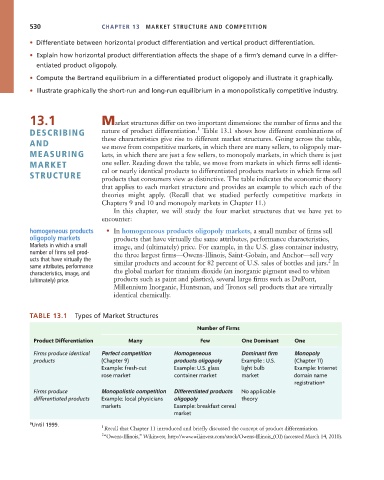Page 556 - Microeconomics, Fourth Edition
P. 556
c13marketstructureandcompetition.qxd 7/30/10 10:44 AM Page 530
530 CHAPTER 13 MARKET STRUCTURE AND COMPETITION
• Differentiate between horizontal product differentiation and vertical product differentiation.
• Explain how horizontal product differentiation affects the shape of a firm’s demand curve in a differ-
entiated product oligopoly.
• Compute the Bertrand equilibrium in a differentiated product oligopoly and illustrate it graphically.
• Illustrate graphically the short-run and long-run equilibrium in a monopolistically competitive industry.
13.1 Market structures differ on two important dimensions: the number of firms and the
1
DESCRIBING nature of product differentiation. Table 13.1 shows how different combinations of
these characteristics give rise to different market structures. Going across the table,
AND we move from competitive markets, in which there are many sellers, to oligopoly mar-
MEASURING kets, in which there are just a few sellers, to monopoly markets, in which there is just
MARKET one seller. Reading down the table, we move from markets in which firms sell identi-
cal or nearly identical products to differentiated products markets in which firms sell
STRUCTURE products that consumers view as distinctive. The table indicates the economic theory
that applies to each market structure and provides an example to which each of the
theories might apply. (Recall that we studied perfectly competitive markets in
Chapters 9 and 10 and monopoly markets in Chapter 11.)
In this chapter, we will study the four market structures that we have yet to
encounter:
homogeneous products • In homogeneous products oligopoly markets, a small number of firms sell
oligopoly markets products that have virtually the same attributes, performance characteristics,
Markets in which a small image, and (ultimately) price. For example, in the U.S. glass container industry,
number of firms sell prod- the three largest firms—Owens-Illinois, Saint-Gobain, and Anchor—sell very
ucts that have virtually the similar products and account for 82 percent of U.S. sales of bottles and jars. In
2
same attributes, performance
characteristics, image, and the global market for titanium dioxide (an inorganic pigment used to whiten
(ultimately) price. products such as paint and plastics), several large firms such as DuPont,
Millennium Inorganic, Huntsman, and Tronox sell products that are virtually
identical chemically.
TABLE 13.1 Types of Market Structures
Number of Firms
Product Differentiation Many Few One Dominant One
Firms produce identical Perfect competition Homogeneous Dominant firm Monopoly
products (Chapter 9) products oligopoly Example : U.S. (Chapter 11)
Example: fresh-cut Example: U.S. glass light bulb Example: Internet
rose market container market market domain name
registration a
Firms produce Monopolistic competition Differentiated products No applicable
differentiated products Example: local physicians oligopoly theory
markets Example: breakfast cereal
market
a
Until 1999. 1 Recall that Chapter 11 introduced and briefly discussed the concept of product differentiation.
2 “Owens-Illinois,” Wikinvest, http://www.wikinvest.com/stock/Owens-Illinois_(OI) (accessed March 14, 2010).

